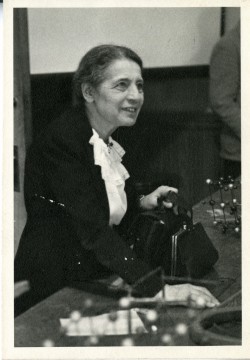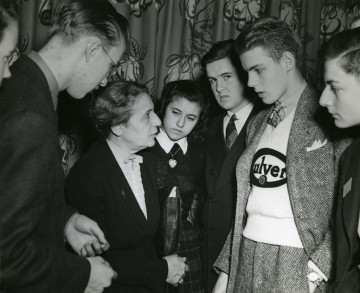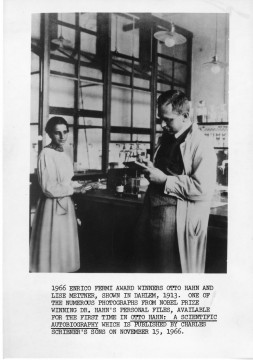Pierre Curie (1859-1906) and Marie Sklodowska Curie (1867-1934), c. 1903
Pierre Curie (1859-1906) and Marie Sklodowska Curie (1867-1934) were jointly awarded the Nobel Prize for Physics in 1903 for discovery of the radioactive elements polonium and radium. Even today, the Curies provide inspiration for popular culture and textbook discussions of science. This photograph was circulated during the 1960s as publicity for an educational television program about the discovery of radium
Lise Meitner (1878-1968), lecturing at Catholic University, Washington, D.C., 1946
In 1938, Austrian-born physicist Lise Meitner (1878-1968) fled Germany and eventually became a Swedish citizen. After World War II, Meitner received many awards, including being named "Woman of the Year" at the National Press Club in 1946. She was a Visiting Professor of Physics at Catholic University during Spring 1946. In a press release associated with her arrival, Dr. Meitner emphasized that her goal was "wholly educational": "I have no intention to suggest how atomic energy should be controlled, beyond expressing my sincere hope that no occasion will again arise where it will be utilized in war. A lasting peace is more desirable than the creation of weapons which might lead to the extermination of mankind."
Lise Meitner (1878-1968) with Science Talent Search finalists, 1946
During Spring 1946, physicist Lise Meitner (1878-1968), of the Royal Swedish Academy of Sciences, was a Visiting Professor of Physics at Catholic University, Washington, D.C., and met with finalists in the Science Talent Search competition. Left to right: James Alexander Hummel, Lise Meitner, Iloka Karasz, James Benjamin Gibson, Stephen Reynolds Arnold, and George Loweree Gaines, Jr.
Lise Meitner (1878-1968) and Otto Hahn (1879-1968), Dahlem, Germany, 1913
This photograph of physicist Lise Meitner (1878-1968) and radiochemist Otto Hahn (1879-1968) in their German laboratory was circulated in 1966 as publicity for the U.S. translation of Hahn's autobiography, Otto Hahn: A Scientific Biography. Although her work was ignored by the Nobel Committee when they awarded the prize to Hahn in 1944, Meitner received many recognitions of her importance to twentieth-century physics, including being the first woman to receive the prestigious Enrico Fermi Award.
Physicists at the Seventh Solvay Physics Conference, Brussels, Belgium, October 1933
This image, which includes in the front row (at left) Irène Joliot-Curie (1897-1956) and (at right) her mother Marie Sklodowska Curie (1867-1934), and in back row (left) her husband Frédéric Joliot (1900-1958), is part of a photograph taken of all attendees. Nearly every major scientist interested in research relating to atomic physics attended that meeting. In the front row are Irene Curie, Niels Henrik David Bohr (1885-1962), Abram Fedorovich Ioffe (1880-1960), and Marie Curie; in the back row (from left) are Joliot, Werner Heisenberg (1901-1976), Hendrik Anthony Kramers (1894-1952), Ernst Stahel (b. 1896), Enrico Fermi (1901-1954), Ernest Thomas Sinton Walton (1903-1995), Paul Adrien Maurice Dirac (1902-1984), Peter Joseph William Debye (1884-1966), Nevill Francis Mott (1905-1996), and Blas Cabrera y Felipe (1878-1945). The black crop lines visible around Fermi's head were made by a Science Service editor.
Bild: Smithsonian Institution
(public domain)
(public domain)





